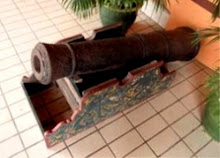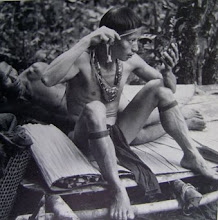The Tuan Muida Charles Brroke was determined to crush Libau RENTAP in his stronghold on the top of Bukit Sadok. On 2nd June,1857 Tuan Muda Charles Brooke organised a war expedition to attack Libau RENTAP with a large group of war men consisting of 3,500 Dayaks and 500 Malays.
The Tuan Muda Charles Brooke war men left Nanga Skrang in a drizzling rain and encountered a very bad weather conditon through out the journey. They proceeded up the Skrang River and on 5th June,1857 their long war boats (Perahu Pengayau) arrived at Sungai Antu where they established a base camp. Forty well armed men were placed in charge of the long war boats (Perahu Pengayau) and baggages whilst the rest of the war men moved overland in the direction of the Bukit Sadok. On 7th June,1857 they saw the Libau RENTAP fort (Kuta) far away in the distance situated at the top of the ridge.
The Tuan Muda Charles Brooke war men resolved to push on that day to Rapu, the northern end of the Bukit Sadok, but found that it could not be done in one day. And only the advance party of the Dayaks could accend the mountain with difficulty and with a very great loss, not only of their lives , but also of confidence and courage as well. The last hundred yards were the almost perpendicular and when they do the mounting and they had to pull themselves up with one hand holding the stunted trees on the ground. At this time one of their foremen was struck by a spear by the Libau RENTAP war men and had to be carried to the rear for his safety.
When the Tuan Muda Charles Brooke was about five yards away from the Libau RENTAP’s war men, he saw many spears being thrown at him and the spears was flying all over his head and some of the spears struck some of his war men in their back. For the whole night the Tuan Muda Charles Brooke sat on the side of the hill at an angle of eighty degrees. His war men have to prepared a few cross-sticks for him to sit, and one of them held a wooden shield at his back to protect him from any attack by the Libau RENTAP war men..
When the morning came the Tuan Muda Charles Brooke and his war men managed to reach the summit of the Bukit Sadok. Along the brow of the Bukit Sadok, at the opposite end they could see clearly the Libau RENTAP fort (Kuta). Several of the Tuan Muda Charles Brooke war men had been killed or wounded on the previous day, and over a hundred of them had rolled down the steep side of the Bukit Sadok. And the Tuan Muda Charles Brooke by doing so had lost a lots of arms and ammunitions.
On 8th June,1857, the Tuan Muda Charles Brooke and his war men was building a stockade at the Rapu. It was located at the end of the Bukit Sadok facing the position being occupied by Libau RENTAP. Libau RENTAP fort (Kuta) was formidable as it was being made of the vertical iron wood (Tebelian) planks which could not be penetrated by the firing of the rifle shots. It was also surrounded on all sides by the steep cliff. Inside the fort (Kuta) the Libau RENTAP war men had built a platformfrom from which they could shoot their enemies who was moving advance in a narrow file along the backbone of a rock leading to the Libau RENTAP fort. It was almost impossible for the Tuan Muda Charles Brooke war men to attack the Libau RENTAP fort (Kuta) from the Rapu end of the Bukit Sadok. Libau RENTAP also had muskets, cannons and a small swivel-gun which Libau RENTAP had captured when Alan Lee was killed at the war battle at the Lintang Batang in 1853.
On 9th June,1857 a group of the Dayak Iban war men who came to assist the Libau RENTAP had made an attemp to attack the Tuan Muda Charles Brooke camp at Rapu. The following day the Tuan Muda Charles Brooke sent a division of Dayaks and Malays to counter-attack them. The Tuan Muda Charles Brooke war men drove them back, then plundered and burnt their longhouses. The Tuan Muda Charles Brooke then tried to get his men to storm the Libau RENTAP fort (Kuta) at night, but they refused to face the risk.
During the next three days the Tuan Muda Charles Brooke war men was busy constructing the portable screens of laths and bamboo known as pilan to be used as their covers while advancing alomg the narrow ridge of the mountain.
At mid-day on the 15th.June,1857 the Tuan Muda Charles Brooke war men started to attack the Libau RENTAP fort (Kuta) under the cover of their pilan. At four o’clock in the afternoon the attacking party had reached a positon within six or seven yards from the Libau RENTAP fort (Kuta). Libau RENTAP and his war men started throwing stones and spears from the fort , which fell on the attacking party. They also used their muskets and small swivel cannons to defend themselves.
At half-past five the Malay leader of the attacking party named Abang Aing was moving advanced under cover of the pilan and tried to set fire to the Libau RENTAP fort (Kuta). But unfortunately for the Tuan Muda Charles Brooke, the gallant Abang Aing was struck by a musket shoot. Abang Aing was wounded and fell to the ground. When the evening came the Tuan Muda Charles Brooke war men had to carry Abang Aing back to their camp. When Libau RENTAP and his war men saw that the gallant Malay leader Abang Aing was wounded, they beat their gongs and yelled loudly with cheers in triumph.
The following day , instead of making another attack at Libau RENTAP fort at Bukit Sadok, the Tuan Muda Charles Brooke wanted to take only about a hundred of the strongest and bravest warrior with himself in command to proceed to Atui to attack the three longhouses belonging to the Dayak Ibans who supported Libau RENTAP. But nobody would volunteer to go with him, some of his war men said that they were sick , while others ran short of provisions.
At eight o’clock in the morning the Tuan Muda Charles Brooke war men began to go down the Bukit Sadok in retreat. Should Libau RENTAP and his war men attack them , then they would suffer greatly, but this was not done. Libau RENTAP was very pleased and satisfied with his success and victory to defend themselves at his fort on Bukit Sadok. Libau RENTAP popularity with the Dayak Ibans increased greatly. The Dayak Iban then strongly believed that Libau RENTAP fort (Kuta) was under the protection of the legendary characters named Keling and Bunga Nuing, which could not be taken by their enemy.
When the Tuan Muda Charles Brooke and his war men had reached their base camp at Sungai Antu they found out that the flood had swept away their stockade and carried off about seventy of their long war boats (Perahu Pengayau). Those who had lost their long war boats had to share with the others while going down the Skrang River. Some of the Libau RENTAP’s war men who was hidding in the thick jungle fired at the retreating party but they suffered no casualty, except those who were already drowned.
The Dayak Ibans who was the Tuan Muda Charles Brooke war men grumbled at the Tuan Muda Charles Brooke for not listening to their comment to the right bird of omen. Thus ended the First Bukit Sadok War Expedition led by the Tuan Muda Charles Brooke against the Libau RENTAP in June , 1857 was a total failure. Libau RENTAP was hilarious of his triump over the White Men.



































